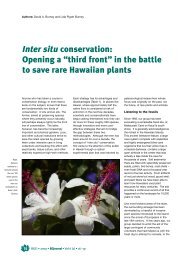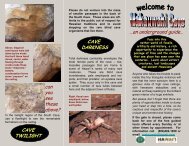PLANT TALK 39 NTBG PAGES - Makauwahi Cave Reserve
PLANT TALK 39 NTBG PAGES - Makauwahi Cave Reserve
PLANT TALK 39 NTBG PAGES - Makauwahi Cave Reserve
You also want an ePaper? Increase the reach of your titles
YUMPU automatically turns print PDFs into web optimized ePapers that Google loves.
From the National Tropical Botanical Garden<br />
Digging into the past to find the future<br />
Palaeo-ecology meets restoration biology<br />
DAVID A. BURNEY<br />
DIRECTOR OF CONSERVATION,<br />
NATIONAL TROPICAL<br />
BOTANICAL GARDEN<br />
Ecological restoration projects in<br />
the Hawaiian lowlands have little<br />
to go on in terms of intact<br />
coastal forest ecosystems to serve as<br />
models. Nevertheless, a program of<br />
palaeo-ecological research has led to some<br />
unique restoration initiatives by the<br />
National Tropical Botanical Garden on<br />
Kauai. For instance, palaeo-botanical<br />
evidence from a cave site a few miles<br />
from <strong>NTBG</strong>’s southshore gardens has<br />
given scientists their most detailed<br />
evidence yet for how coastal vegetation<br />
before humans would have looked. As it<br />
turns out, the list of species in coastal dry<br />
forests was quite long and included many<br />
endangered taxa that are represented in<br />
the wild today only by a few individuals<br />
at remote inland sites, or that are extinct<br />
on the island but have survived on a<br />
neighbouring island.<br />
On both the north and south shores of<br />
Kauai, <strong>NTBG</strong> has several exciting new<br />
restoration projects with ties to palaeoecology<br />
and archaeobotany. These<br />
include a project along the coast fronting<br />
the Allerton Garden, an area called Lawai<br />
Kai, which was initiated by grants from<br />
the US Fish & Wildlife Service and the<br />
Natural Resources Conservation Service<br />
(USDA). In the more inland parts of the<br />
Lawai Valley, <strong>NTBG</strong>’s McBryde Garden<br />
has new restoration projects underway<br />
aimed at protecting rare plant species<br />
adapted to dry upland conditions on the<br />
island’s leeward slopes. Initial funding of<br />
the project in McBryde was made possible<br />
through <strong>NTBG</strong> Fellows, a major<br />
support group of the organization.<br />
<strong>NTBG</strong>’s Limahuli Garden on the north<br />
shore has restored traditional Polynesian<br />
pondfields and other dramatic landscapes<br />
through careful attention to the details of<br />
local oral traditions and data from adjacent<br />
archaeological sites.<br />
A key link in the process of finding the<br />
successful path to restoration against the<br />
odds posed by aggressive alien plants and<br />
animals has been that <strong>NTBG</strong> staff pay<br />
close attention to ecological history in<br />
planning its restorative efforts. Hawaiian<br />
oral traditions, early historical accounts,<br />
and particularly information from archaeological<br />
and palaeo-ecological sites near<br />
the restorations have provided useful<br />
evidence concerning the site’s potential<br />
for restoration, serving as reference<br />
systems or restoration targets for various<br />
projects.<br />
At <strong>Makauwahi</strong> <strong>Cave</strong> on Kauai’s spectacular<br />
Mahaulepu coast, our research group<br />
has excavated more than 200 m 3 of sediment<br />
from a sinkhole palaeolake in the<br />
centre of the cave system, yielding a<br />
10,000-year record of changes in sea level,<br />
environmental conditions and biota. The<br />
fossil-rich mud of this site has yielded<br />
about 45 species of fossil birds, for<br />
instance, as well as more than a dozen<br />
types of extinct land snails, and a rich<br />
record of early Polynesian diet and lifeways.<br />
Most germane to the question of<br />
what types of vegetation grew there in the<br />
past and could be targets for future<br />
restorations, of course, were abundant<br />
well-preserved fossil spores and pollen,<br />
seeds and fruits, and even leaves, twigs<br />
and whole tree trunks.<br />
This material showed that, for thousands<br />
of years before human arrival, the site was<br />
surrounded by a woodland dominated by<br />
a small-fruited native loulu palm<br />
(Pritchardia cf. aylmer-robinsonii) and a<br />
wide array of trees and shrubs. This<br />
remarkable vegetation included plenty of<br />
kou (Cordia subcordata), a species formerly<br />
believed by most botanists to have been<br />
brought to the islands by Polynesians.<br />
Our radiocarbon dating shows clearly<br />
that this tree, as well as hala (Pandanus<br />
tectorius), were part of the indigenous<br />
flora.<br />
David A. Burney<br />
Volunteers remove invasive grasses<br />
and plant native strand plant along the<br />
beach at Lawai Kai in the historic<br />
Allerton Garden.<br />
46 <strong>PLANT</strong><strong>TALK</strong> <strong>39</strong> January 2005
Armed with this kind of information<br />
from the past, <strong>NTBG</strong> embarked last year<br />
on the ambitious restoration of the spectacular<br />
beach and adjacent coastal forest<br />
at Lawai Kai. The project’s first goal was<br />
to remove the exotic grasses from the<br />
beach strand, which had crowded out<br />
most native strand plants and hardened<br />
the beach’s substrate so that the<br />
Hawaiian green sea turtle or honu<br />
(Chelonia mydas) had stopped nesting<br />
there. Additional challenges were to<br />
create a vegetation barrier to ameliorate<br />
the effects of marine overwash (the structures<br />
on the site had been damaged<br />
previously by a tsunami and two hurricanes),<br />
while retaining the ocean view.<br />
Add to this the need to remove aliens,<br />
which made up much of the plant biomass,<br />
and create stable habitat for a wide<br />
array of highly endangered endemic<br />
plants, and the order is tall indeed.<br />
A plan was developed in late 2003 that<br />
addressed these requirements and deliberately<br />
followed the fossil and historical<br />
evidence to design a vegetative landscape<br />
aimed at mimicking the kind of plant<br />
assemblage that would have been there<br />
about a millennium ago – shortly after<br />
Polynesian arrival. Evidence from excavations<br />
at <strong>Makauwahi</strong> as well as 6000-year<br />
sediment cores from Lawai Kai’s own<br />
estuary and about a dozen other palaeoecological<br />
and archaeobotanical sites<br />
around Kauai were combined with<br />
present and historical records for plants<br />
to generate a very long species list. Many<br />
of those plants, including rare palms,<br />
trees and shrubs endemic to the island,<br />
now thrive on the three-acre restoration.<br />
David A. Burney<br />
Similarly, at Limahuli Garden on the<br />
north shore, ancient oral traditions have<br />
guided the reconstruction of taro pondfields<br />
in the lowermost parts of the valley.<br />
Higher up, a three-man restoration team<br />
battles exotic weed trees and plants out<br />
hundreds of natives grown in <strong>NTBG</strong><br />
nurseries. Nearby, a sediment core from a<br />
coastal fen contained a 9,000-year record<br />
of sedimentation in a windward, highrainfall<br />
area, including evidence for megatsunamis<br />
and flood events.<br />
<strong>NTBG</strong> has been able to spread this successful<br />
approach, utilizing a deep-time<br />
perspective to guide ecological restoration<br />
efforts, in collaboration with other<br />
landowners on Kauai. The restoration<br />
activities on the 15 acres surrounding the<br />
<strong>Makauwahi</strong> <strong>Cave</strong> was made possible by<br />
the cooperation of Grove Farm<br />
Company, which leased the land to the<br />
research group. Similarly, our 7,000-year<br />
sediment cores from the Bette Midler<br />
Trust property in the Kawaihau Wetlands<br />
on Kauai’s east coast provided a pollen<br />
and spore record to guide restoration<br />
planning there in cooperation with the<br />
Natural Resources Conservation Service<br />
(USDA). Similar collaborations with the<br />
State of Hawaii and US Fish & Wildlife<br />
Service may help in the effort to re-establish<br />
rare Hawaiian plant species on<br />
Lehua, a small islet and seabird colony<br />
just offshore from the nearby island of<br />
Niihau. These and other <strong>NTBG</strong> projects<br />
and collaborations may be the best<br />
chance for many rare Hawaiian plant<br />
species to have any sort of future at all.<br />
There is a supreme irony in this turn of<br />
affairs. In order to provide some plants<br />
with a future, we must look to the past.<br />
In a sense <strong>NTBG</strong>’s mission has grown to<br />
embrace an exciting new concept in<br />
conservation – an approach that holds<br />
out the possibility of staving off extinction<br />
by consulting with the ancestors,<br />
especially those of the plants themselves!<br />
National Tropical Botanical Garden<br />
is a non-profit institution, dedicated to<br />
tropical plant conservation and<br />
research and to sharing what is<br />
learned. For more information, please<br />
visit our website at www.ntbg.org<br />
http://www.ntbg.org/ or contact us at<br />
(808) 332-7324.<br />
Nursery Manager Bob Nishek<br />
growing native plants for the Dry<br />
Forest Restoration Project in <strong>NTBG</strong>’s<br />
McBryde Garden. Paleoecological<br />
studies of leeward areas of Kauai have<br />
shown that, before their destruction in<br />
recent centuries, dry forests were<br />
remarkably diverse.<br />
January 2005 <strong>PLANT</strong><strong>TALK</strong> <strong>39</strong><br />
47




